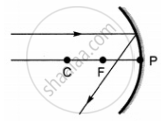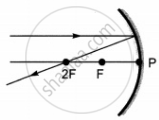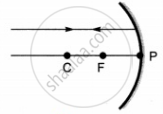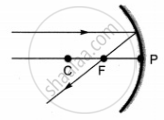Advertisements
Advertisements
Question
A spherical mirror and a thin spherical lens have each a focal length of -15 cm. The mirror and the lens are likely to be ______.
Options
both concave
both convex
the mirror is concave and the lens is convex
the mirror is convex, but the lens is concave
Solution
A spherical mirror and a thin spherical lens have each a focal length of -15 cm. The mirror and the lens are likely to be both concave.
Explanation:
By convention, the focal length of a concave mirror and the focal length of a concave lens are taken as negative. Hence, both the spherical mirror and the thin spherical lens are concave in nature.
APPEARS IN
RELATED QUESTIONS
Draw a ray diagram to show the path of the reflected ray corresponding to an incident ray of light parallel to the principal axis of a concave mirror. Mark the angle of incidence and angle of reflection on it.
Name the mirror that can give an erect and enlarged image of an object.
Out of convex mirror and concave mirror, whose focus is situated behind the mirror?
With the help of a ray diagram, determine the position, nature and size of the image formed of an object placed at the centre of curvature of a concave mirror.
Name the type of mirror used by dentists. How does it help?
If the object is moved further away from the mirror, what changes are there in the position and size of the image?
Between which two points of concave mirror should an object be placed to obtain a magnification of:
(a) −3
(b) +25
(c) −0.4
At what distance from a concave mirror of focal length 10 cm should an object be placed so that:
its virtual image is formed 20 cm from the mirror?
Name the mirror which can give:
an erect and enlarged image of an object.
If the radius of curvature of a concave mirror is 20 cm, its focal length is:
Draw a ray diagram to show the formation of image of an object placed at the centre of curvature of a concave mirror. State the position, size and nature of the image.
How can a concave mirror be used to obtain a virtual image of an object? Draw a diagram to illustrate your answer.
State two uses of a concave mirror.
A student has to determine the focal length of a concave mirror by obtaining the image of a distant object on a screen. For getting best result he should focus
(A) a distant tree or an electric pole
(B) a well-illuminated distant building
(C) well-lit grills of the nearest window
(D) a burning candle laced at the distant edge of the laboratory table
The radius of curvature of a concave mirror whose focal length is 5cm is ______
Large ______ mirrors are used to concentrate sunlight to produce heat in solar furnaces.
According to cartesion sign convention, which mirror and which lens has negative focal length?
Which of the following ray diagrams is correct for the ray of light incident on a concave mirror as shown in figure?

 |
 |
 |
 |
| A | B | C | D |
______ mirrors make things look larger when objects are placed close to them.
A student took three concave mirrors of different focal lengths and performed the experiment to see the image formation by placing an object at different distance with these mirrors as shown in the following table.
| Case No. | Object-distance | Focal length |
| I | 45 cm | 20 cm |
| II | 30 cm | 15 cm |
| III | 20 cm | 30 cm |
Now answer the following questions:
(a) List two properties of the image formed in Case I.
(b) In which one of the cases given in the table, the mirror will form real image of same size and why?
(c) Name the type of mirror used by dentists. Given reason why do they use such type of mirrors.
OR
(c) Look at the table and identify the situation (object distance and focal length) which resembles the situation in which concave mirrors are used as shaving mirrors? Draw a ray diagram to show the image formation in this case.
